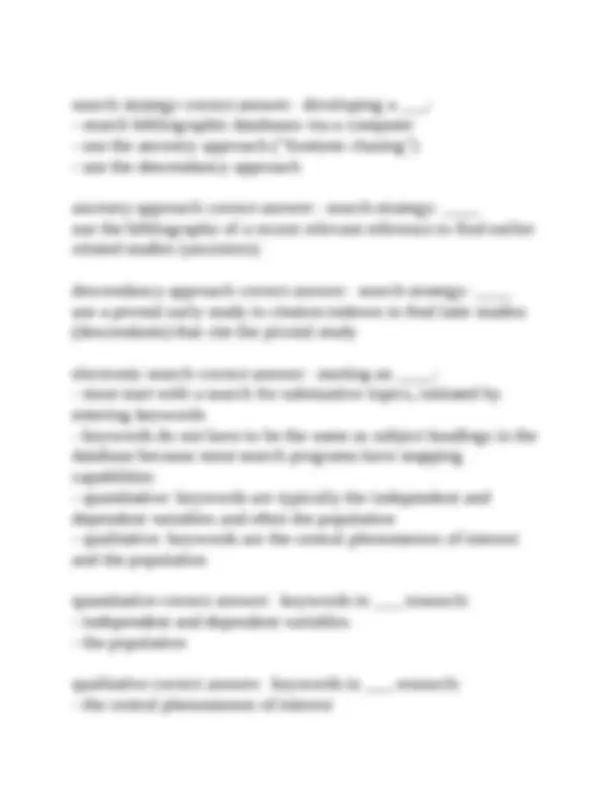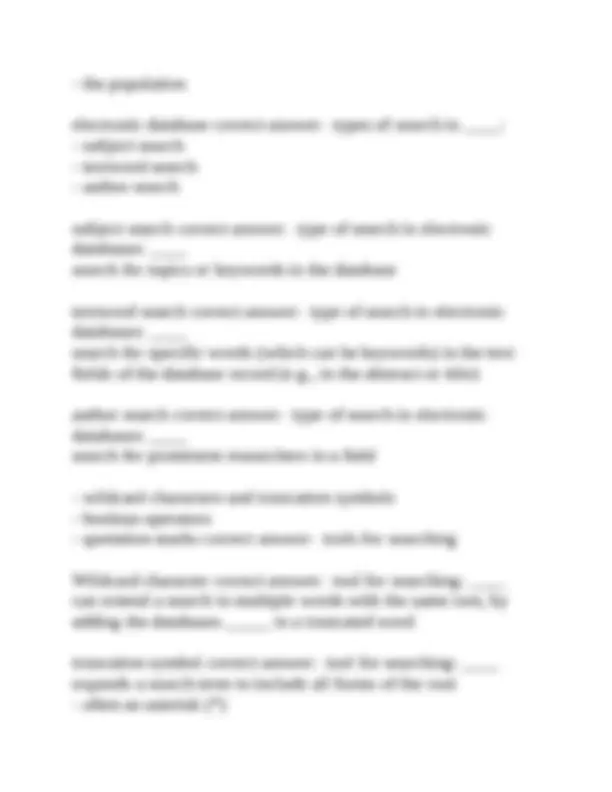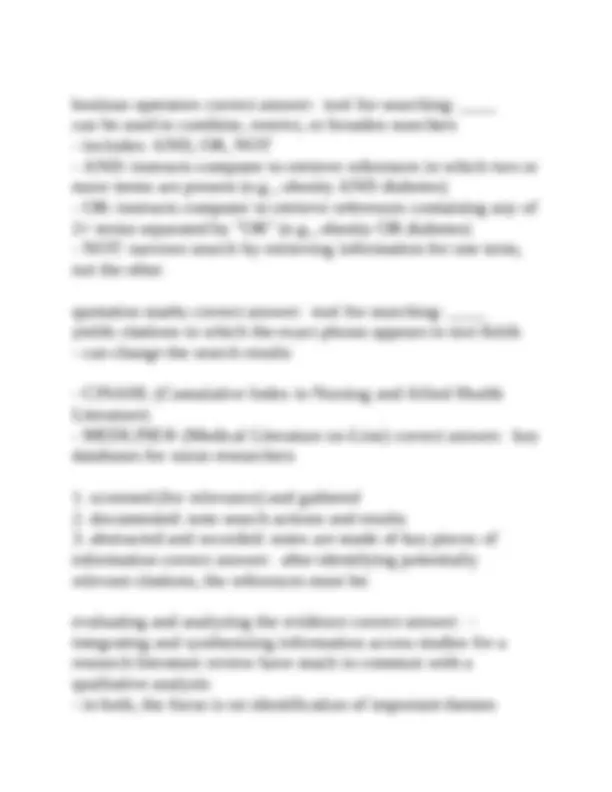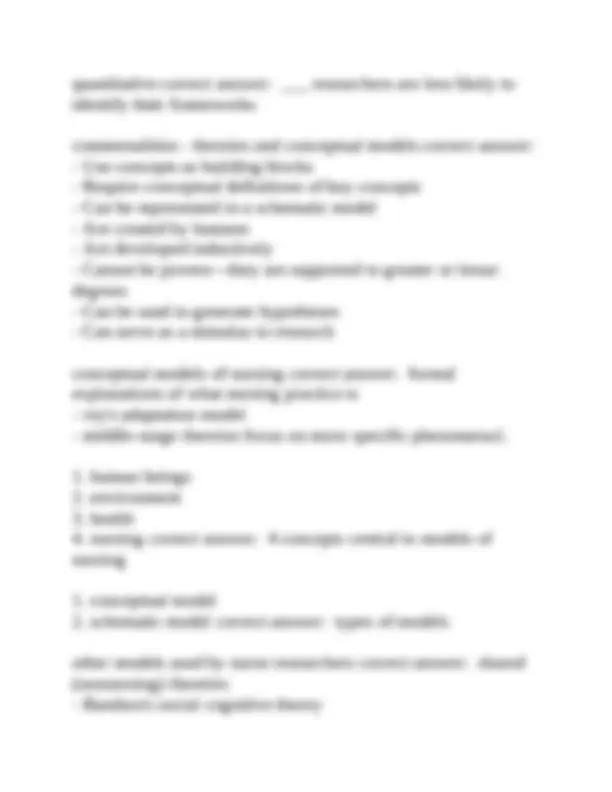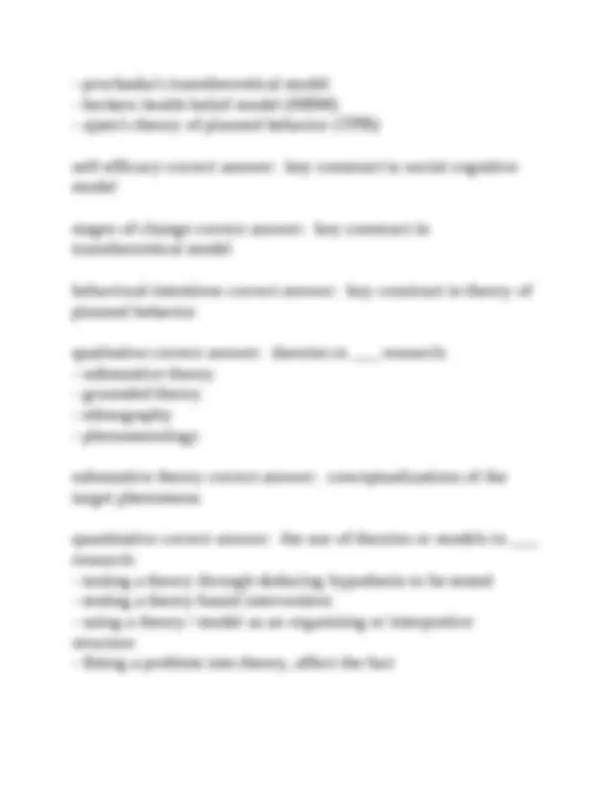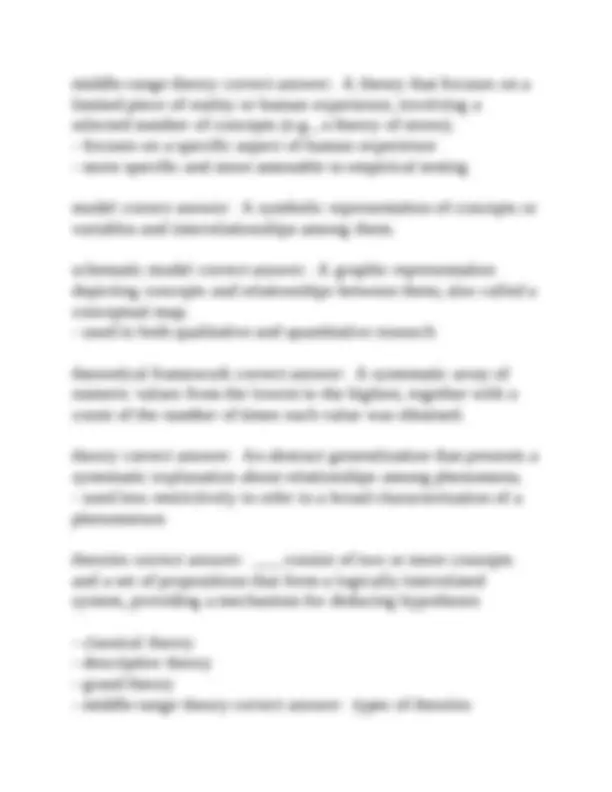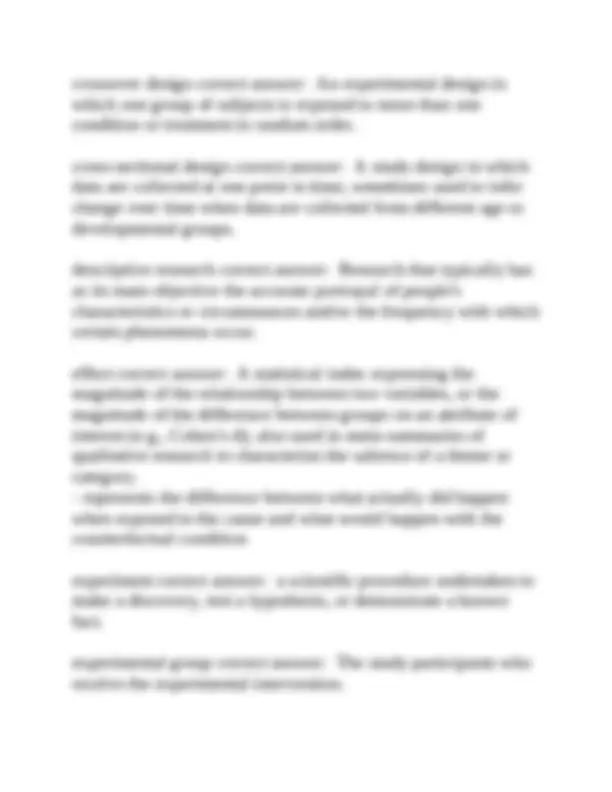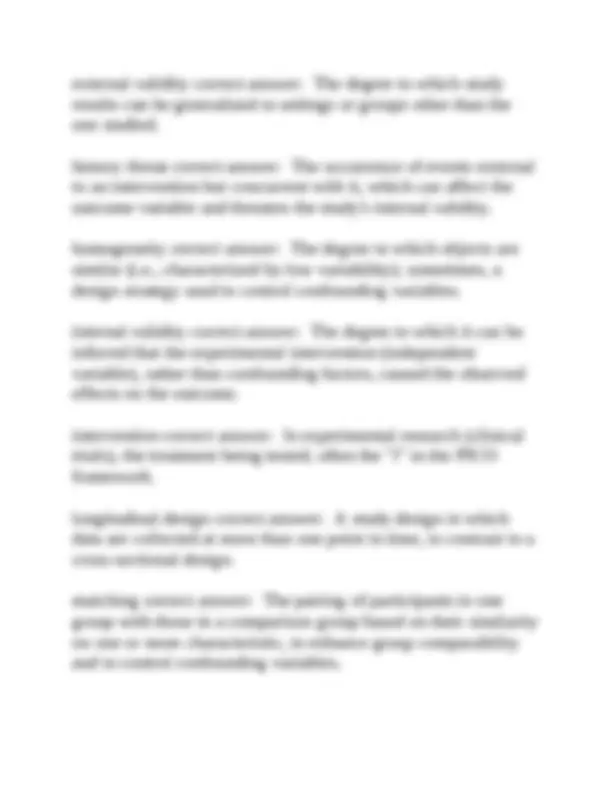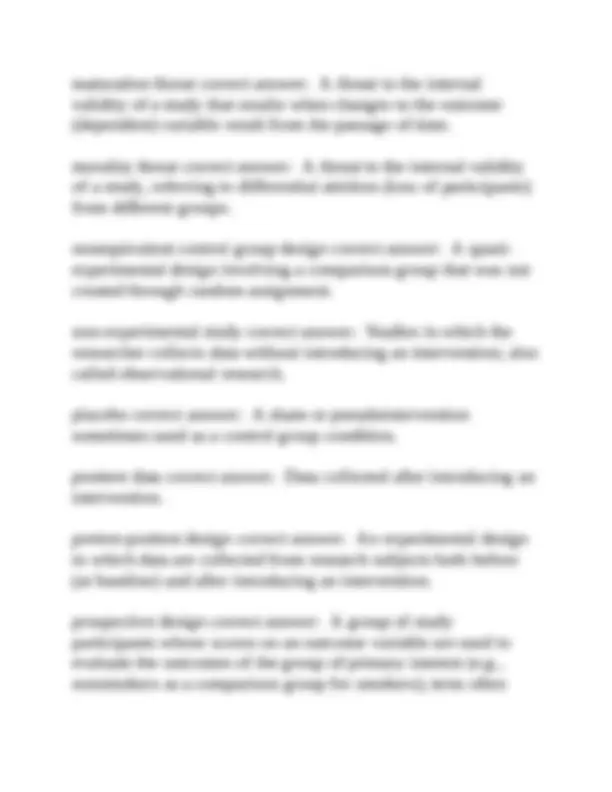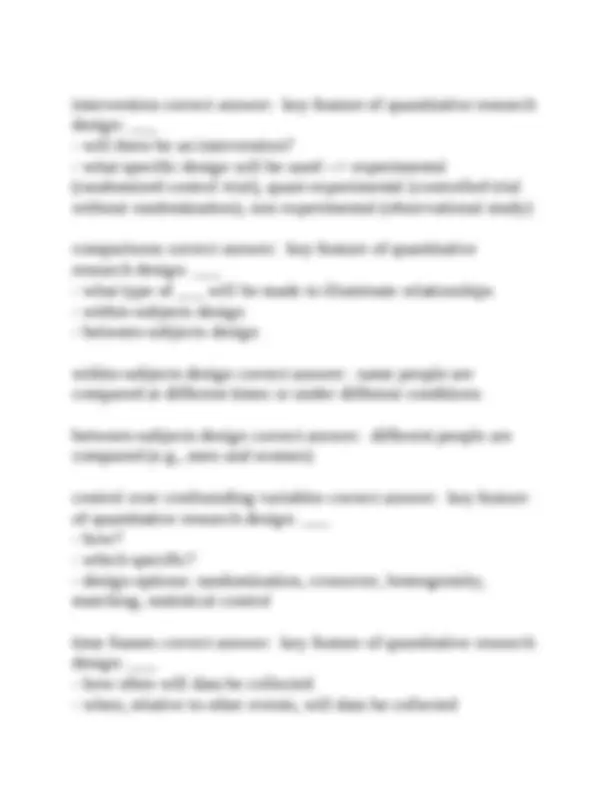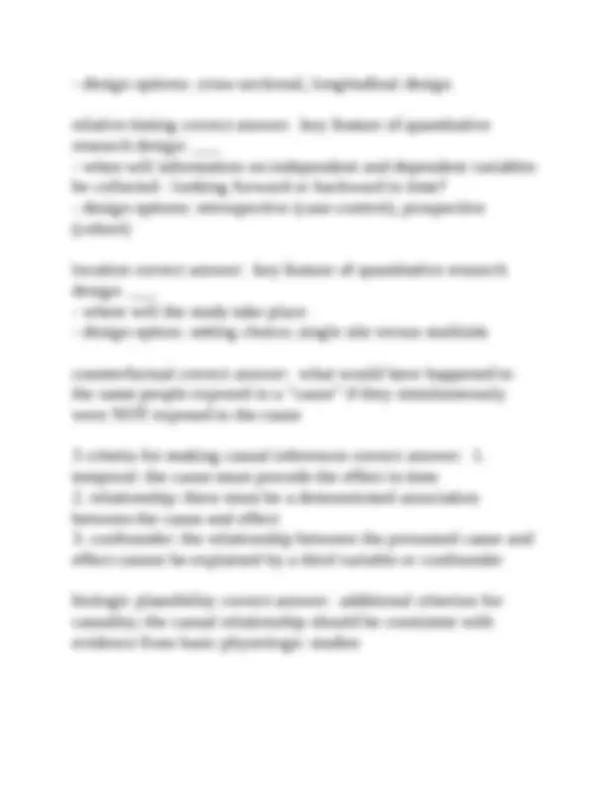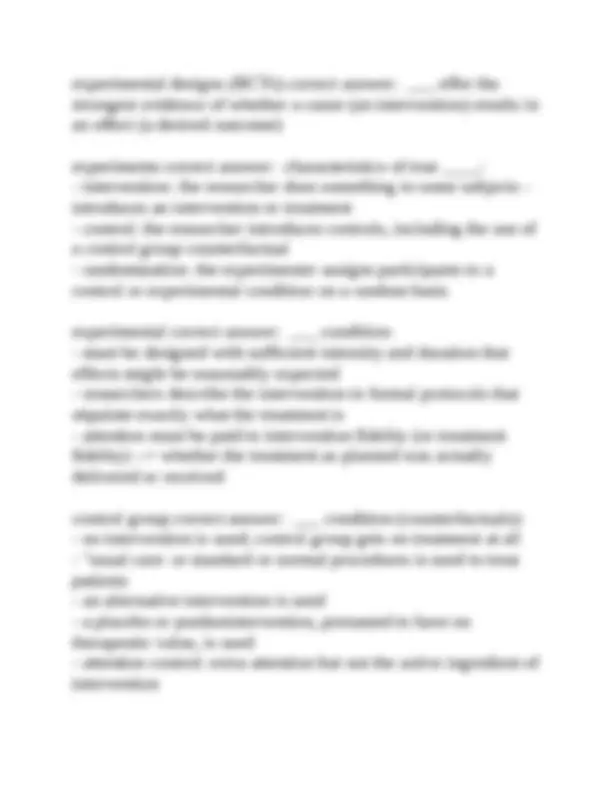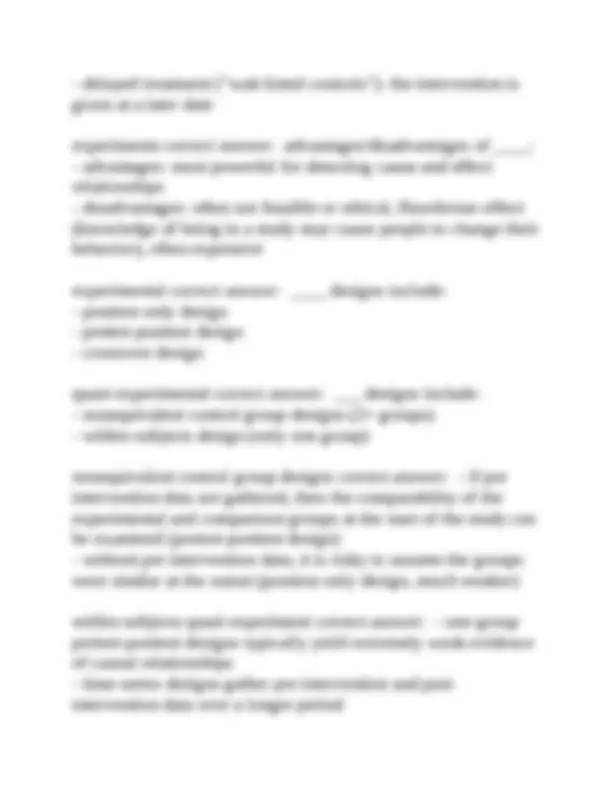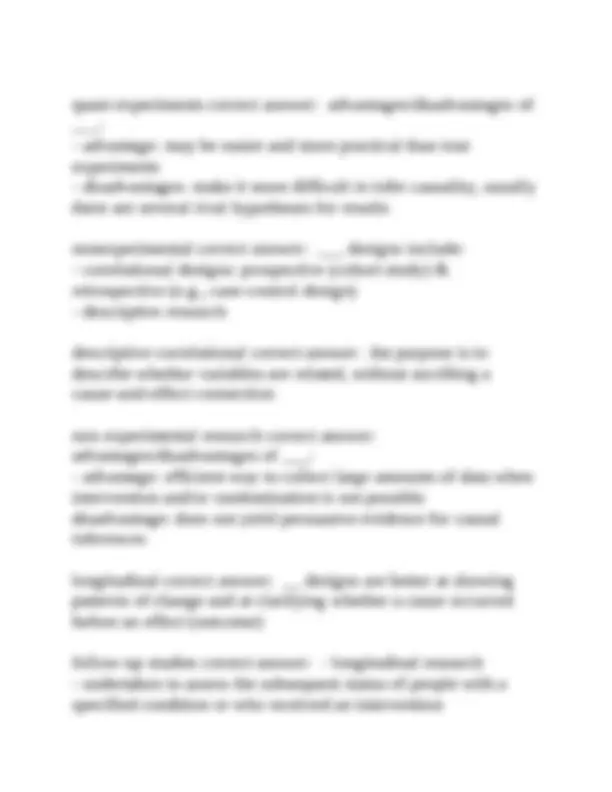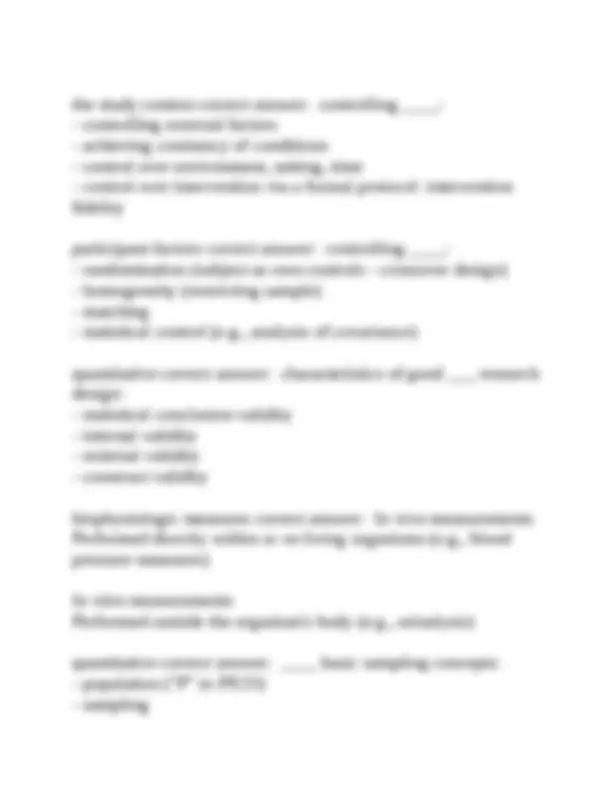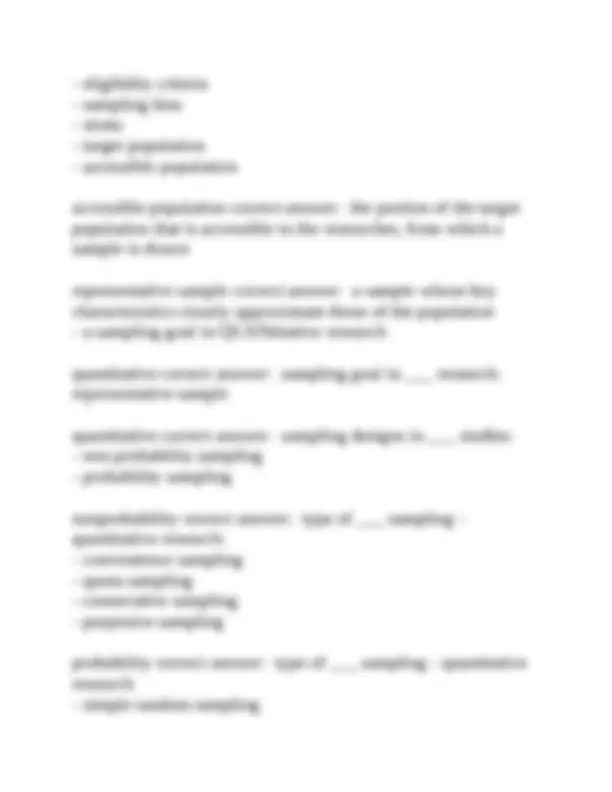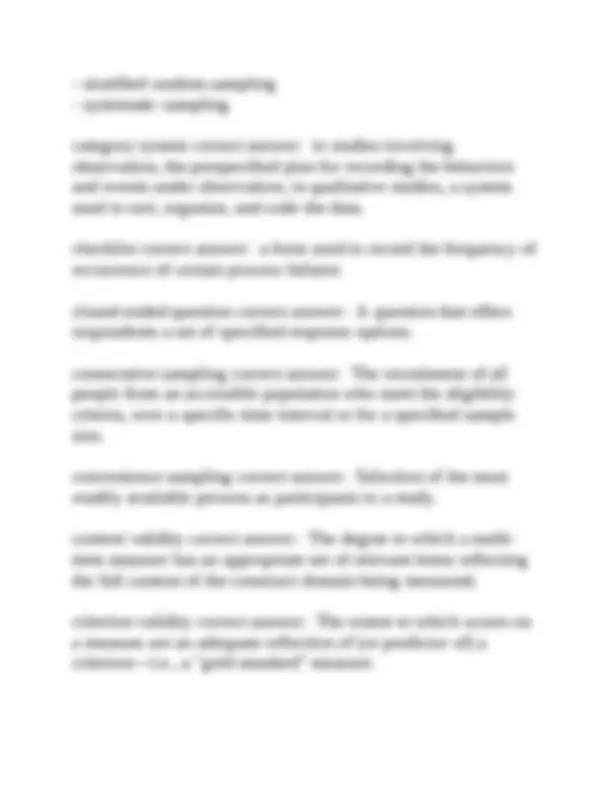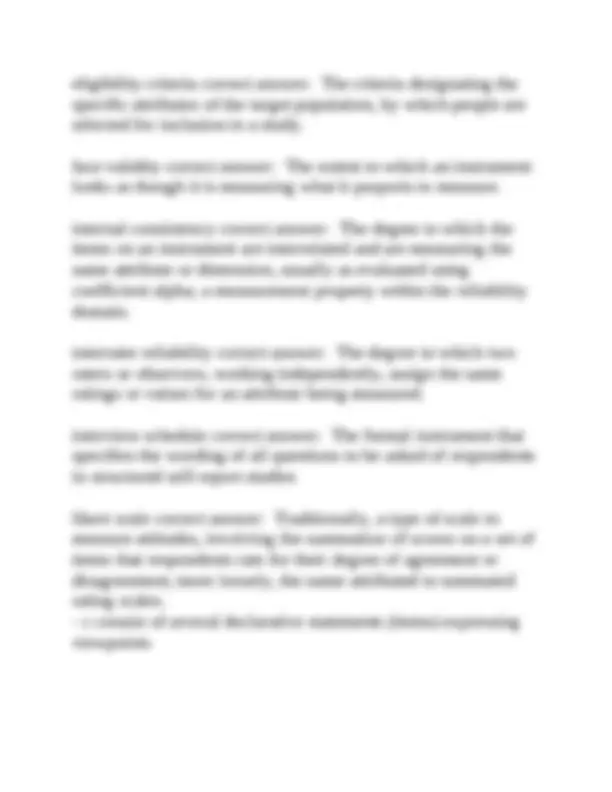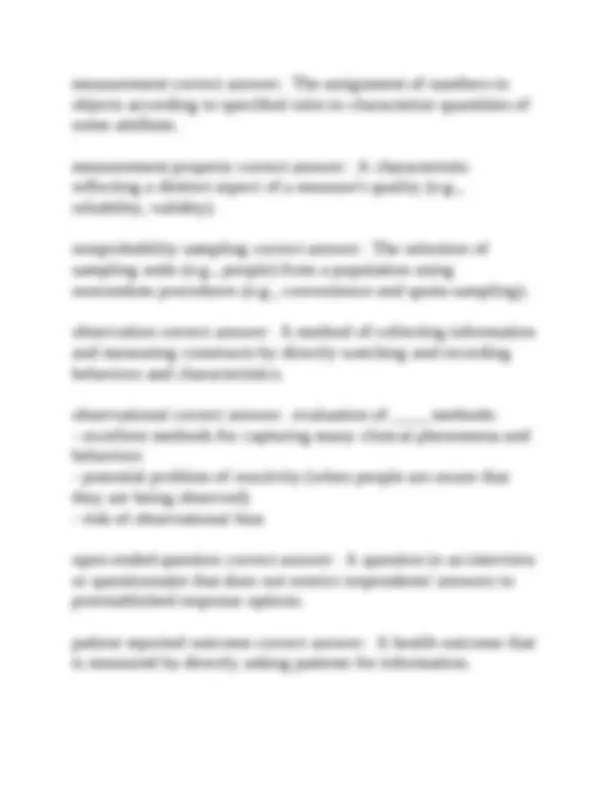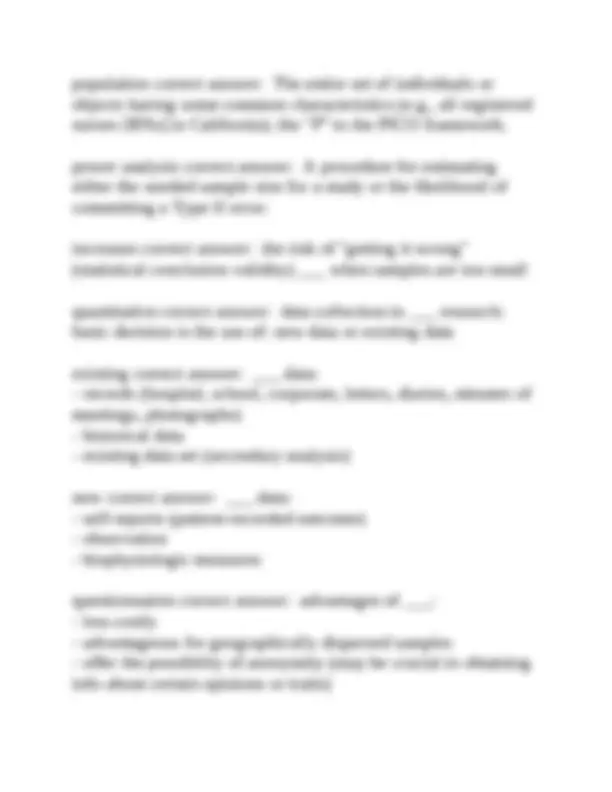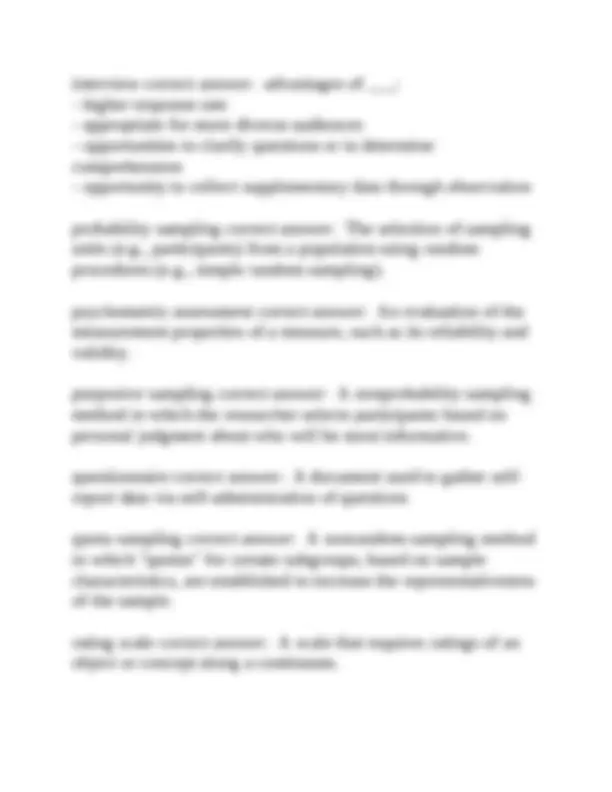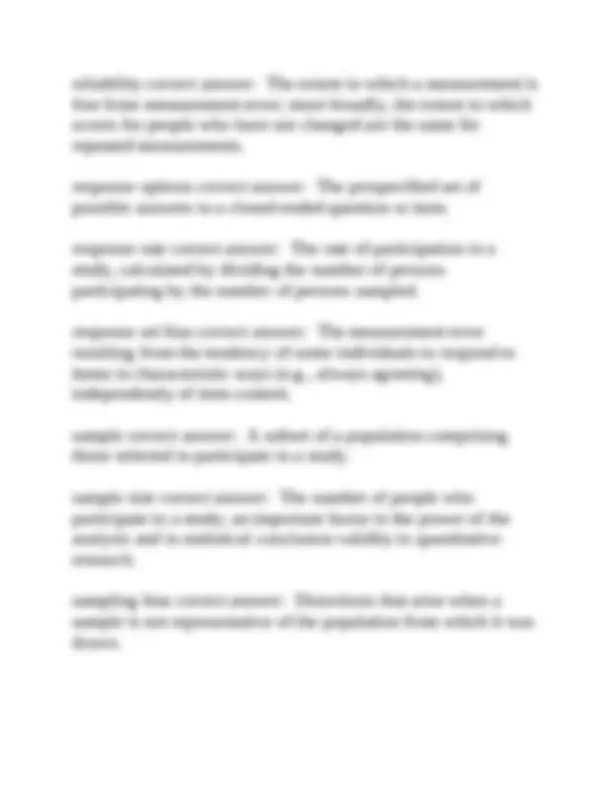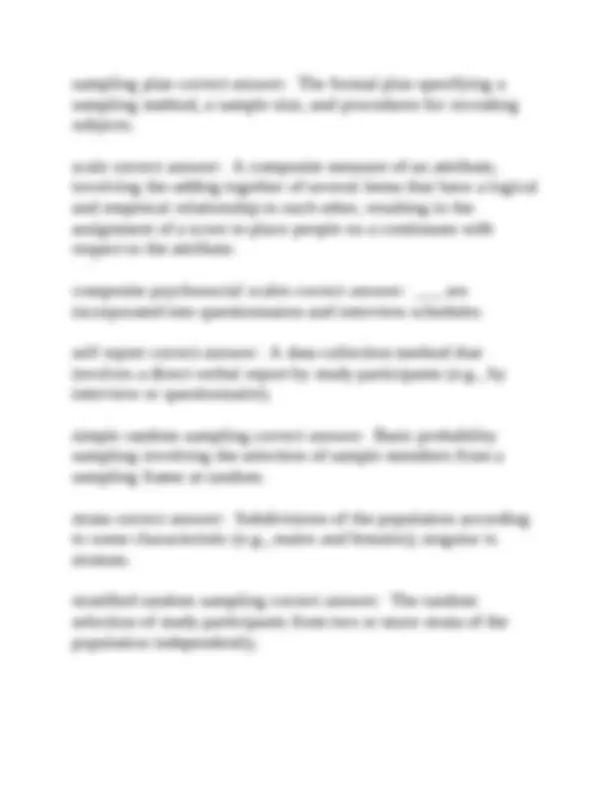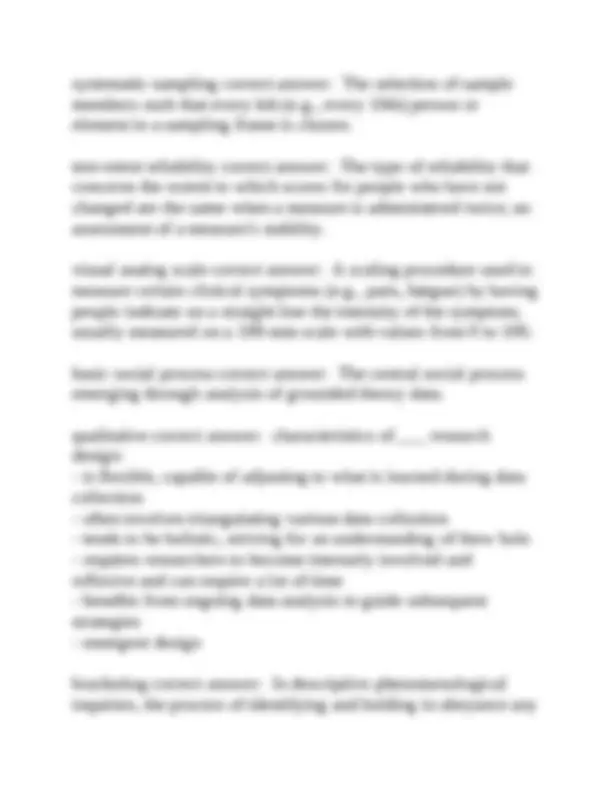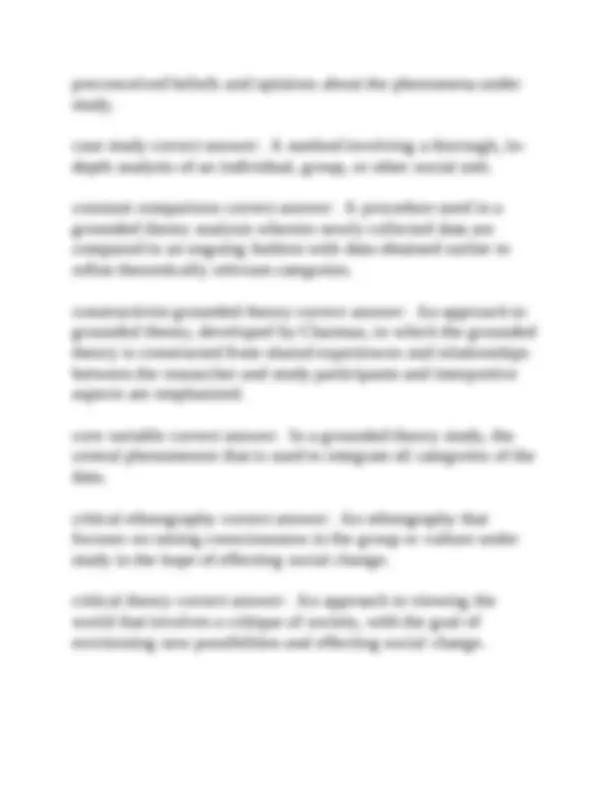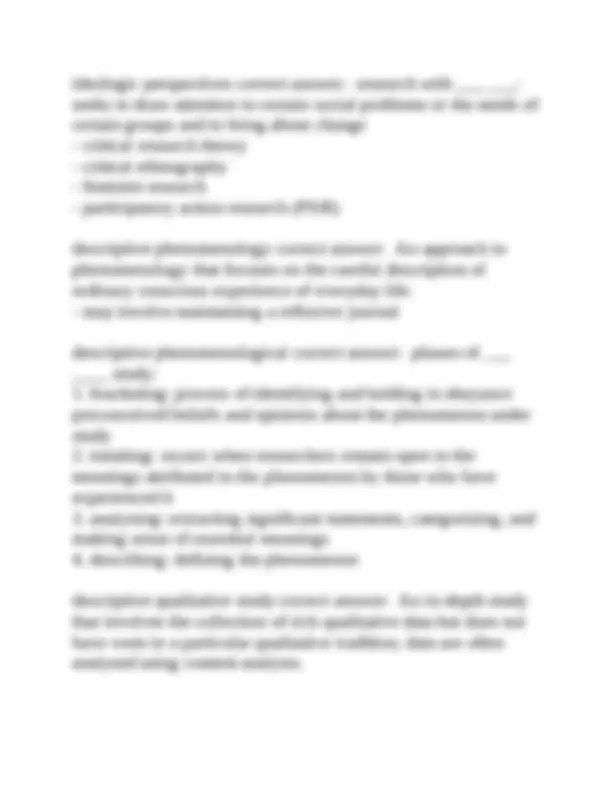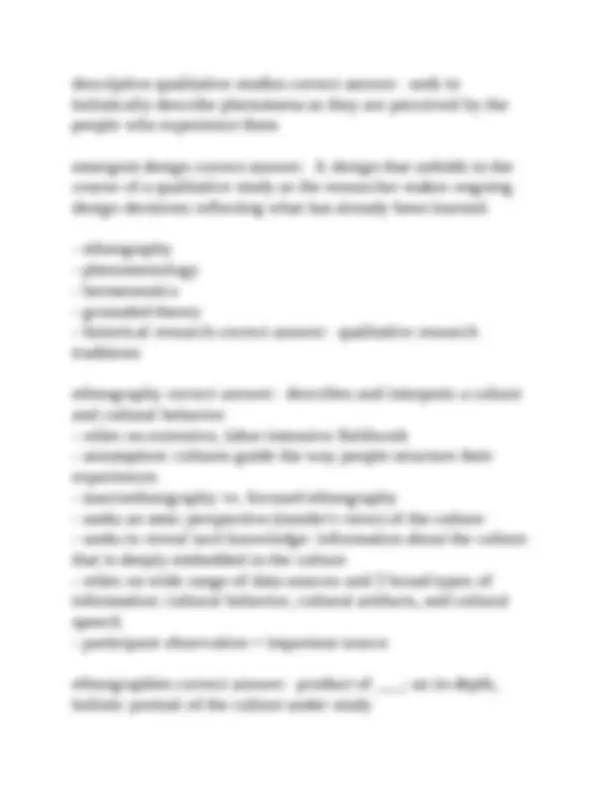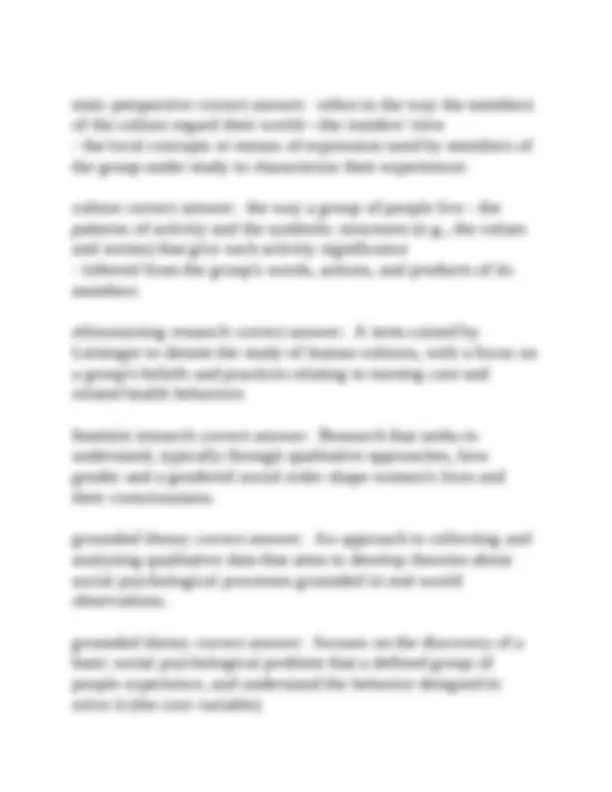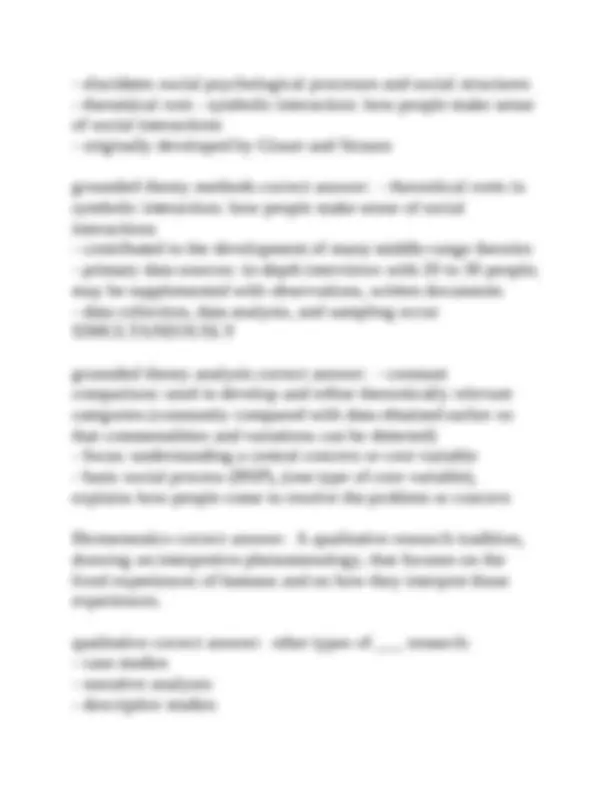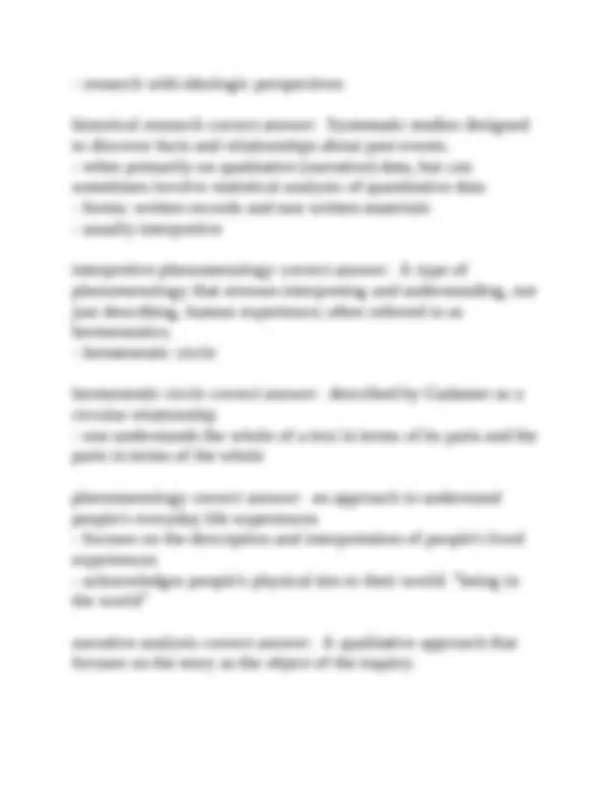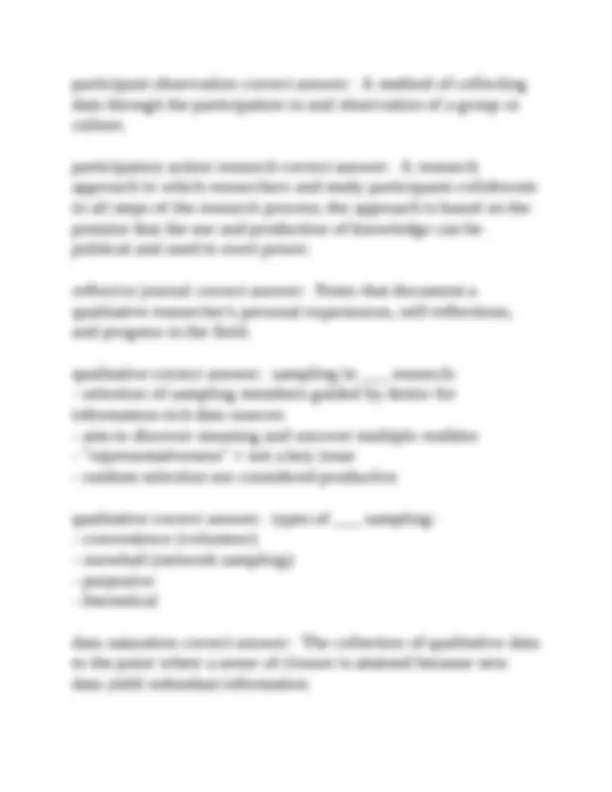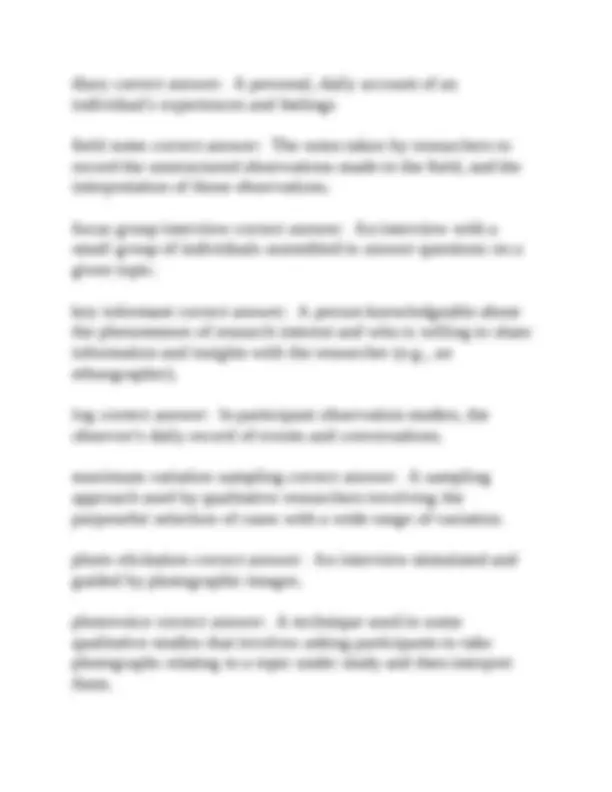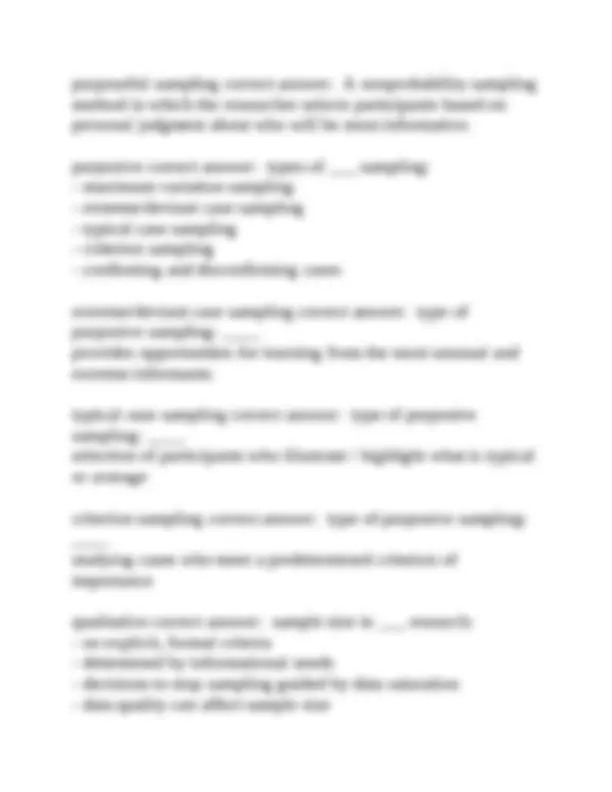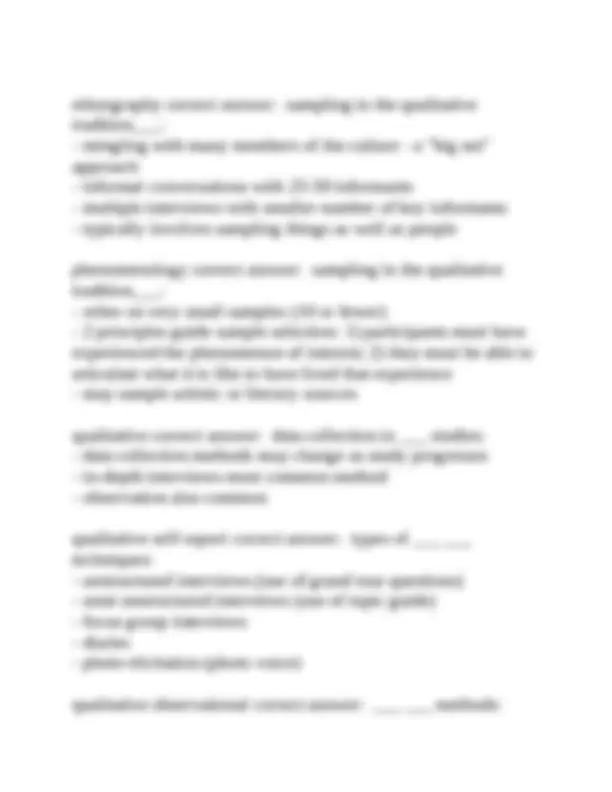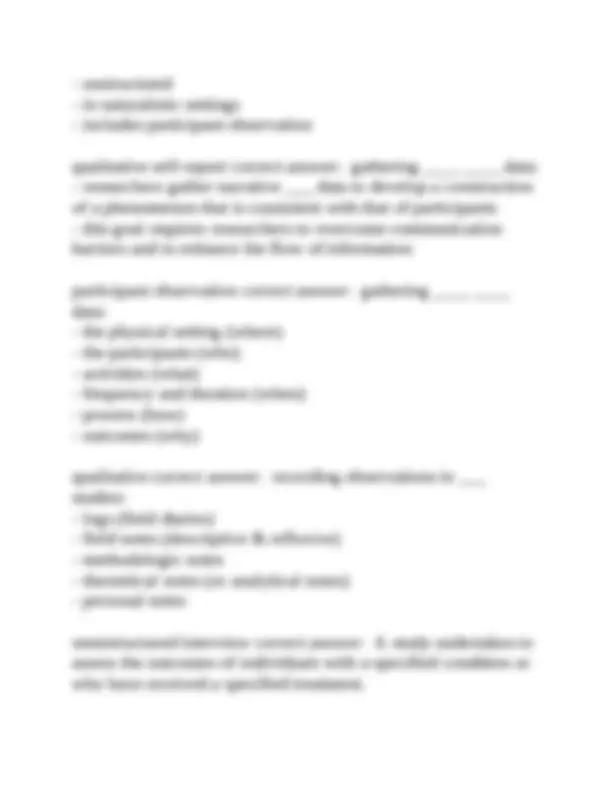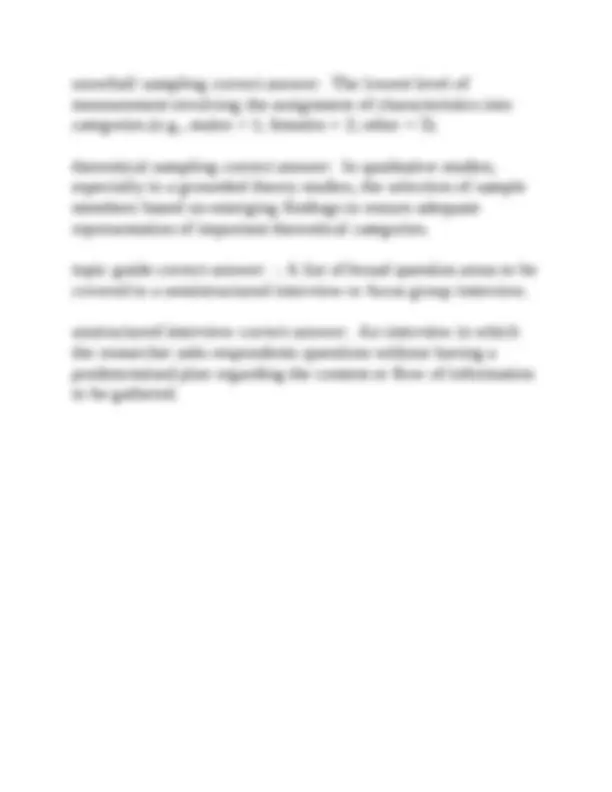Download NURS 262 Exam 2 Questions and Answers: A Guide to Nursing Research and more Exams Nursing in PDF only on Docsity!
NURS 262 Exam 2 Questions With
Complete Solutions
bibliographic database correct answer: An important term used to search for references on a topic in a bibliographic database. CINAHL correct answer: the acronym used for the Cumulative Index to Nursing & Allied Health, which is a reference database that provides authoritative coverage of the literature related to nursing and allied health (from 1982-present)
- contains citations, abstracts (for most entries), and names of any data collection instruments Google Scholar correct answer: a freely accessible search engine launched by Google in 2004 that provides a simple way to broadly search for scholarly literature, such as published scientific or medical articles
- allows user to search by topic, by a title, and uses Boolean operators and other search conventions keyword correct answer: An important term used to search for references on a topic in a bibliographic database. literature review correct answer: A critical summary of research on a topic, often prepared to put a research problem in context or to summarize existing evidence. literature review correct answer: purposes of a _____:
- integrate research evidence to sum up what is known and not known
- communicate the state of evidence to others
- lay the foundation for new studies
- help researchers interpret their findings MEDLINE correct answer: the largest searchable database covering medicine, health, and biomedical research
- can be accessed for free anywhere in the world via PubMed
- uses a controlled vocabulary called MeSH MeSH correct answer: (Medical Subject Headings) a controlled vocabulary used to index articles in MEDLINE primary source correct answer: Firsthand reports of facts or findings; in research, the original report prepared by the investigator who conducted the study.
- primary sources (principle reliance on these)
- secondary sources (less reliance on these)
- non research references: clinical anecdotes, opinion articles, and case reports (may broaden understanding of a problem or demonstrate a need for research) correct answer: types of information for a research review PubMed correct answer: a computerized database that allows access to approximately 11 million biomedical journal citations secondary source correct answer: Secondhand accounts of events or facts; in research, a description of a study prepared by someone other than the original researcher.
- the population electronic database correct answer: types of search in ____:
- subject search
- textword search
- author search subject search correct answer: type of search in electronic databases: ____ search for topics or keywords in the database textword search correct answer: type of search in electronic databases: ____ search for specific words (which can be keywords) in the text fields of the database record (e.g., in the abstract or title) author search correct answer: type of search in electronic databases: ____ search for prominent researchers in a field
- wildcard characters and truncation symbols
- boolean operators
- quotation marks correct answer: tools for searching Wildcard character correct answer: tool for searching: ____ can extend a search to multiple words with the same root, by adding the databases _____ to a truncated word truncation symbol correct answer: tool for searching: ____ expands a search term to include all forms of the root
- often an asterisk (*)
boolean operators correct answer: tool for searching: ____ can be used to combine, restrict, or broaden searchers
- includes: AND, OR, NOT
- AND: instructs computer to retrieve references in which two or more terms are present (e.g., obesity AND diabetes)
- OR: instructs computer to retrieve references containing any of 2+ terms separated by "OR" (e.g., obesity OR diabetes)
- NOT: narrows search by retrieving information for one term, not the other quotation marks correct answer: tool for searching: ____ yields citations in which the exact phrase appears in text fields
- can change the search results
- CINAHL (Cumulative Index to Nursing and Allied Health Literature)
- MEDLINE® (Medical Literature on-Line) correct answer: key databases for nurse researchers
- screened (for relevance) and gathered
- documented: note search actions and results
- abstracted and recorded: notes are made of key pieces of information correct answer: after identifying potentially relevant citations, the references must be: evaluating and analyzing the evidence correct answer: - integrating and synthesizing information across studies for a research literature review have much in common with a qualitative analysis
- in both, the focus is on identification of important themes
- conclude with a concise state-of-the-art summary of the existing evidence conceptual framework correct answer: A written framework to guide the development, preparation, and interpretation of financial accounting information. conceptual map correct answer: A schematic representation of a theory or conceptual model that graphically represents key concepts and linkages among them. conceptual model correct answer: Interrelated concepts or abstractions assembled together in a rational scheme by virtue of their relevance to a common theme; sometimes called conceptual framework.
- represents a more loosely structured attempt to explain phenomena than theories
- can serve as springboard for generating hypotheses descriptive theory correct answer: A broad characterization that thoroughly accounts for a phenomenon. framework correct answer: A schematic representation of a theory or conceptual model that graphically represents key concepts and linkages among them.
- the overall conceptual underpinnings of a study implicit correct answer: a study's framework is often ___ (not formally acknowledged or described)
quantitative correct answer: ___ researchers are less likely to identify their frameworks commonalities - theories and conceptual models correct answer:
- Use concepts as building blocks
- Require conceptual definitions of key concepts
- Can be represented in a schematic model
- Are created by humans
- Are developed inductively
- Cannot be proven—they are supported to greater or lesser degrees
- Can be used to generate hypotheses
- Can serve as a stimulus to research conceptual models of nursing correct answer: formal explanations of what nursing practice is
- roy's adaptation model
- middle-range theories focus on more specific phenomena1.
- human beings
- environment
- health
- nursing correct answer: 4 concepts central to models of nursing
- conceptual model
- schematic model correct answer: types of models other models used by nurse researchers correct answer: shared (nonnursing) theories:
- Bandura's social cognitive theory
middle-range theory correct answer: A theory that focuses on a limited piece of reality or human experience, involving a selected number of concepts (e.g., a theory of stress).
- focuses on a specific aspect of human experience
- more specific and more amenable to empirical testing model correct answer: A symbolic representation of concepts or variables and interrelationships among them. schematic model correct answer: A graphic representation depicting concepts and relationships between them; also called a conceptual map.
- used in both qualitative and quantitative research theoretical framework correct answer: A systematic array of numeric values from the lowest to the highest, together with a count of the number of times each value was obtained. theory correct answer: An abstract generalization that presents a systematic explanation about relationships among phenomena.
- used less restrictively to refer to a broad characterization of a phenomenon theories correct answer: ___ consist of two or more concepts and a set of propositions that form a logically interrelated system, providing a mechanism for deducing hypotheses
- classical theory
- descriptive theory
- grand theory
- middle-range theory correct answer: types of theories
classical theory correct answer: an abstract generalization that systematically explains relationships among phenomena grand theory correct answer: a theory that attempts to explain large aspects of human experiences attrition correct answer: The loss of participants over the course of a study, which can create bias by changing the characteristics of the sample from those of the sample initially drawn. baseline data correct answer: Data collected at an initial measurement (e.g., prior to an intervention) so that changes can be evaluated. blinding correct answer: The process of preventing those involved in a study (participants, intervention agents, data collectors, or health care providers) from having information that could lead to a bias, particularly information about which treatment group a participant is in; also called masking case-control design correct answer: A nonexperimental design that compares "cases" (people with a specified condition, such as lung cancer) to matched controls (similar people without the condition) cause correct answer: A relationship between two variables wherein the presence or value of one variable (the "cause") determines the presence or value of the other (the "effect").
crossover design correct answer: An experimental design in which one group of subjects is exposed to more than one condition or treatment in random order. cross-sectional design correct answer: A study design in which data are collected at one point in time; sometimes used to infer change over time when data are collected from different age or developmental groups. descriptive research correct answer: Research that typically has as its main objective the accurate portrayal of people's characteristics or circumstances and/or the frequency with which certain phenomena occur. effect correct answer: A statistical index expressing the magnitude of the relationship between two variables, or the magnitude of the difference between groups on an attribute of interest (e.g., Cohen's d); also used in meta-summaries of qualitative research to characterize the salience of a theme or category.
- represents the difference between what actually did happen when exposed to the cause and what would happen with the counterfactual condition experiment correct answer: a scientific procedure undertaken to make a discovery, test a hypothesis, or demonstrate a known fact. experimental group correct answer: The study participants who receive the experimental intervention.
external validity correct answer: The degree to which study results can be generalized to settings or groups other than the one studied. history threat correct answer: The occurrence of events external to an intervention but concurrent with it, which can affect the outcome variable and threaten the study's internal validity. homogeneity correct answer: The degree to which objects are similar (i.e., characterized by low variability); sometimes, a design strategy used to control confounding variables. internal validity correct answer: The degree to which it can be inferred that the experimental intervention (independent variable), rather than confounding factors, caused the observed effects on the outcome. intervention correct answer: In experimental research (clinical trials), the treatment being tested; often the "I" in the PICO framework. longitudinal design correct answer: A study design in which data are collected at more than one point in time, in contrast to a cross-sectional design. matching correct answer: The pairing of participants in one group with those in a comparison group based on their similarity on one or more characteristic, to enhance group comparability and to control confounding variables.
used in lieu of control group when the study design is not a true experiment. quasi-experiment correct answer: A type of design for testing an intervention in which participants are not randomly assigned to treatment conditions; also called a nonrandomized trial or a controlled trial without randomization. randomization correct answer: The assignment of subjects to treatment conditions in a random manner (i.e., in a manner determined by chance alone); also called random assignment. randomized control trial correct answer: A full experimental test of an intervention, involving random assignment to treatment groups; sometimes, is phase III of a full clinical trial. research design correct answer: The overall plan for addressing a research question, including strategies for enhancing the study's integrity. retrospective design correct answer: A study design that begins with the manifestation of the outcome variable in the present (e.g., lung cancer), and a search for a presumed cause occurring in the past (e.g., cigarette smoking). selection threat correct answer: A threat to a study's internal validity resulting from preexisting differences between groups under study; the differences affect the outcome in ways extraneous to the effect of the independent variable.
statistical conclusion validity correct answer: The degree to which inferences about relationships from a statistical analysis of the data are correct. statistical power correct answer: The ability of a research design and analytic strategy to detect true relationships among variables. threats to validity correct answer: In research design, reasons that an inference about the effect of an independent variable (e.g., an intervention) on an outcome could be wrong. time-series design correct answer: A quasi-experimental design involving the collection of data over an extended time period, with multiple data collection points both prior to and after introducing an intervention. validity correct answer: A quality criterion referring to the degree to which inferences made in a study are accurate and well-founded; in measurement, the degree to which an instrument measures what it is intended to measure. quantitative correct answer: key features of ___ research design:
- intervention
- comparisons
- control over confounding variables
- blinding
- time frames
- relative timing
- location
- design options: cross-sectional, longitudinal design relative timing correct answer: key feature of quantitative research design: ___
- when will information on independent and dependent variables be collected - looking forward or backward in time?
- design options: retrospective (case-control), prospective (cohort) location correct answer: key feature of quantitative research design: ___
- where will the study take place
- design option: setting choice; single site versus multisite counterfactual correct answer: what would have happened to the same people exposed to a "cause" if they simultaneously were NOT exposed to the cause 3 criteria for making causal inferences correct answer: 1. temporal: the cause must precede the effect in time
- relationship: there must be a demonstrated association between the cause and effect
- confounder: the relationship between the presumed cause and effect cannot be explained by a third variable or confounder biologic plausibility correct answer: additional criterion for causality; the casual relationship should be consistent with evidence from basic physiologic studies
experimental designs (RCTs) correct answer: ___ offer the strongest evidence of whether a cause (an intervention) results in an effect (a desired outcome) experiments correct answer: characteristics of true ____:
- intervention: the researcher does something to some subjects - introduces an intervention or treatment
- control: the researcher introduces controls, including the use of a control group counterfactual
- randomization: the experimenter assigns participants to a control or experimental condition on a random basis experimental correct answer: ___ condition:
- must be designed with sufficient intensity and duration that effects might be reasonably expected
- researchers describe the intervention in formal protocols that stipulate exactly what the treatment is
- attention must be paid to intervention fidelity (or treatment fidelity) --> whether the treatment as planned was actually delivered or received control group correct answer: ___ condition (counterfactuals):
- no intervention is used; control group gets no treatment at all
- "usual care: or standard or normal procedures is used to treat patients
- an alternative intervention is used
- a placebo or pseduointervention, presumed to have no therapeutic value, is used
- attention control: extra attention but not the active ingredient of intervention

